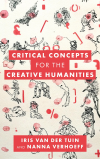- doi.org/10.5771/9781538147757
- ISBN print: 978-1-5381-4773-3
- ISBN online: 978-1-5381-4775-7
- Rowman & Littlefield, Lanham Rowman & Littlefield, Lanham
Zusammenfassung
This concise, precise, and inclusive dictionary contributes to a growing, transforming, and living research culture within both humanities scholarship and professional practices within the creative sectors. Its format of succinct starting definitions, demonstrations of possible routes of further development, and references to new and revisited concepts as “conceptual invitations” allows readers to quickly uptake and orient themselves within this exciting methodological field for didactic, scholarly and creative use, and as a starting point for further investigation for future contributions to the new canon of critical concepts.
Critical Concepts for the Creative Humanities is the first book to outline and define the specific and evolving field of the creative humanities and provides the field’s nascent bibliography.
Schlagworte
Digital media Philosophy technology Performance art cultural studies art theory Art Practice Creative PracticeKeywords
critical theory social studies- Kapitel Ausklappen | EinklappenSeiten
- i–xii Preface i–xii
- 1–10 Introduction 1–10
- 11–13 Accent 11–13
- 14–16 Accident 14–16
- 17–19 Affect 17–19
- 20–22 Ambient 20–22
- 26–28 Assembling 26–28
- 29–31 Asterisk * 29–31
- 35–37 Both/And 35–37
- 47–49 Classifixation 47–49
- 50–52 Collage 50–52
- 55–57 Condition 55–57
- 58–60 Contagion 58–60
- 61–63 Contingency 61–63
- 64–65 Crossing 64–65
- 66–67 Curation 66–67
- 68–70 Dash –, Hyphen - 68–70
- 71–73 Deixis 71–73
- 74–77 Diffraction 74–77
- 78–80 Dirt 78–80
- 81–83 Dispositif 81–83
- 84–86 Dramaturgy 84–86
- 87–89 Eco-, Ecology 87–89
- 90–92 Encounter 90–92
- 93–95 Engagement 93–95
- 96–97 Failure 96–97
- 98–100 Figuration 98–100
- 101–103 Following 101–103
- 104–106 Friction 104–106
- 107–108 Generation, Generative 107–108
- 109–111 Gesture 109–111
- 112–113 Glow 112–113
- 114–116 Habit 114–116
- 117–118 Hashtag # 117–118
- 119–120 Implication 119–120
- 121–122 Interface 121–122
- 128–130 Making Kin, Unkinning 128–130
- 131–133 Micrology 131–133
- 137–139 Navigation 137–139
- 140–142 Openness 140–142
- 143–145 Pluriverse 143–145
- 146–148 Prefiguration 146–148
- 149–151 Procedure 149–151
- 152–154 Proposition 152–154
- 155–157 Punctuation 155–157
- 158–160 Randomization 158–160
- 161–163 Rhythm 161–163
- 164–166 Risk 164–166
- 167–169 Scale, Scaling 167–169
- 170–172 Scape, -scapes 170–172
- 173–175 Situation, Situatedness 173–175
- 176–177 Somatechnics 176–177
- 178–180 Speculation 178–180
- 181–183 Sticky, Stickiness 181–183
- 184–186 Surface 184–186
- 187–189 Sympathy 187–189
- 190–192 Synchrony, Synchronicity 190–192
- 196–198 Trace, Tracing 196–198
- 199–200 Trans-, Transing 199–200
- 201–203 Unlearning 201–203
- 204–206 Wonder 204–206
- 207–208 Zetesis 207–208
- 209–216 Index of Concepts 209–216
- 217–224 Index of Names 217–224
- 225–242 Bibliography 225–242
- 243–244 About the Authors 243–244

